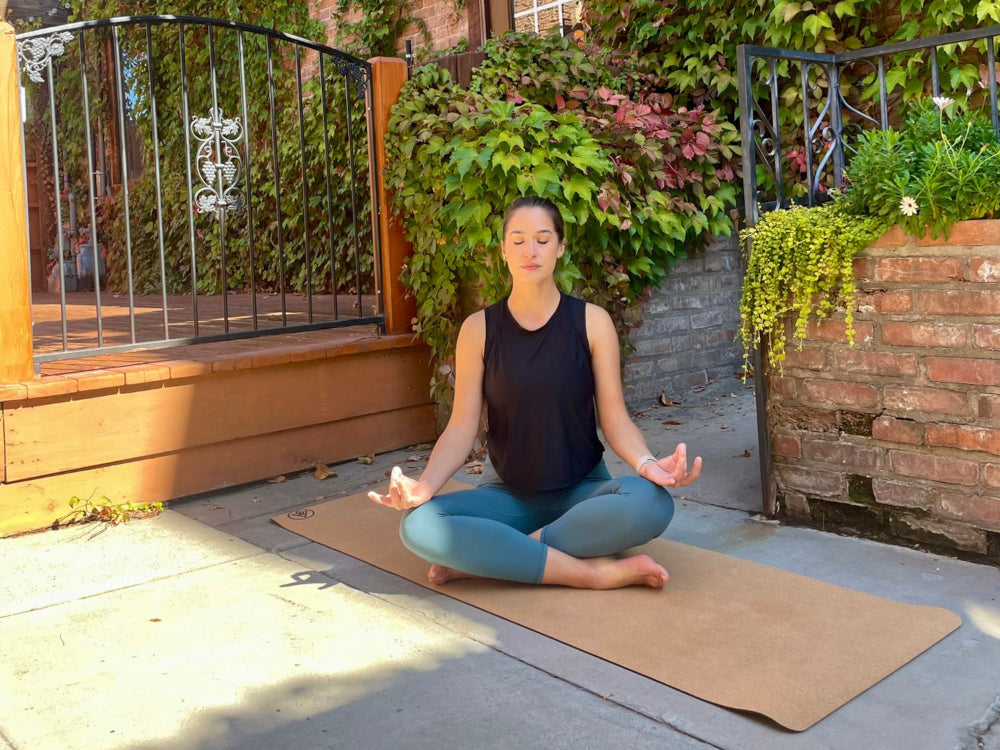
Vishnu Mudra - Nose Seal
Jack UtermoehlShare
Vishnu Mudra (Nose Seal) aka Nasika Mudra
Sanskrit Name: Viṣṇu Mudrā - विष्णु मुद्रा sometimes called "Naśīka Mudrā"
English Translation: Nose Seal
Phonetic Spelling: VISH-noo Moo-Drah
Vishnu mudra, also known as nasika mudra (nose seal), is often used in pranayama practices like nadi shodhana (alternate nostril breathing). Named after Lord Vishnu, the Preserver, this mudra is essential in balancing the energy channels of the body, Ida and Pingala, through breath control.
This balance creates harmony between the body’s solar and lunar energies, evoking physical, mental, and spiritual equilibrium. Vishnu is revered as the Preserver of the universe, and through this mudra, practitioners can invoke stability, balance, and focus.
The value of Vishnu mudra comes from its use in pranayama. Nadi shodhana is one of the most commonly practiced and used pranayamas in yoga and meditation.

Instructions to Perform Vishnu Mudra
Sit comfortably with a straight spine, preparing for pranayama.
Hand Position: Fold your index and middle fingers into the palm, touching the base of the thumb. Keep the ring and little fingers extended and connected. Use your thumb to gently close the right nostril and your ring and little fingers to close the left nostril as needed.
Posture: Sit in sukhasana (easy pose) or padmasana (lotus pose).
Breathing Technique: Use Vishnu mudra during nadi shodhana by alternating between nostrils to regulate the flow of breath through the body’s energy channels.
Duration: Practice for 5-15 minutes during pranayama.
Benefits of Vishnu Mudra
Vishnu mudra supports pranayama practices, particularly alternate nostril breathing, by aiding breath control and balancing the body's energy pathways.
Physical Benefits: Enhances respiratory function, improves breath control, and calms the nervous system.
Mental Benefits: Balances the left and right hemispheres of the brain, promotes focus, and reduces mental stress.
Emotional Benefits: Encourages mental clarity and calm, reducing anxiety and emotional imbalance.
Spiritual Benefits: Activates and harmonizes the body’s energy pathways, evoking inner balance and spiritual growth.
Capture your insights and deepen your connection with our Yoga Journal.Elevate Your Mudra Practice
Symbolism and Meaning of Vishnu Mudra
Named after the deity Vishnu, the Preserver, Vishnu mudra represents balance, protection, and stability. In pranayama, it helps balance the body’s energy channels, known as nadis, specifically Ida (left, lunar energy) and Pingala (right, solar energy). By controlling the flow of breath through the nostrils, Vishnu mudra harmonizes both sides of the body.
The practice of alternate nostril breathing with this mudra enhances vitality, focus, and mental clarity. Vishnu mudra is essential for practitioners seeking to balance their inner pranic flow and achieve a state of balance.
When to Practice Vishnu Mudra
Vishnu mudra is ideal for use during pranayama, especially alternate nostril breathing (nadi shodhana) and sun-piercing breath (Surya bhedana). It helps balance the body's energy systems, preparing the mind for meditation or deeper yoga practices.
Practice this mudra in the morning or before meditation to stabilize the mind and body. A duration of 5-15 minutes per session is recommended.
Contraindications for Vishnu Mudra
Vishnu mudra is safe for most practitioners. There are no specific contraindications; however, those with nasal congestion may find alternate nostril breathing challenging.
Additional Insights on Vishnu Mudra
Affirmations: "I balance my breath, energy, and mind with ease." / "I am calm and centered through the harmony of my breath."
Visualization: As you hold Vishnu mudra, visualize the balance of lunar and solar energy within your body. Imagine a steady flow of prana, harmonizing both sides of your body, bringing calm and focus.
Associated Chakras: Vishnu mudra helps balance the Ida and Pingala nadis, indirectly influencing Ajna (third eye) chakra near the nadi’s terminal points and Muladhara (root chakra) where Ida and Pingala nadi originate.
Paired Asanas: Works well with seated postures like padmasana (lotus pose) or vajrasana (thunderbolt pose).
Related Pranayama: Pair Vishnu mudra with nadi shodhana (alternate nostril breathing) or Surya bhedana (sun-piercing breath).
Meditation Techniques: Vishnu mudra is ideal for breath-focused digital pranayama practices, regulating the flow of breath through the nostrils.
Variations and Modifications
Alternative Hand Positions: None
Adaptations for Beginners: Beginners can start by practicing vishnu mudra for shorter periods, such as 2-5 minutes, and gradually increase the time as they become more comfortable.
—— 🕉 ——

Personal Insights
I was introduced to Vishnu mudra early in my practice. What I found so fascinating was how it felt natural to hold and manage my breath with this 'claw' like hand shape. Later learning that I'm regulating more than just my breath through my nose but the prana through Ida and Pingala really changed my practice.
I began to focus less on the sensation of air and more on the sensation of energy in my body.
Feeling prana enter and exit like sun and moon shining on me with each breath. Sun for Pingala, the right nostril. And Moon for Ida, the left nostril. In fact, I began visualizing the Sun and Moon energy entering my body with each inhale, swirling in my solar plexus as inhale transitions to exhale, releasing that energy back into the world around me.
I love Vishnu mudra and I highly recommend its use.
I later found some people breaking Vishnu mudra to place their index and middle finger on their third eye. This seems to activate the egoic mind in my practice. Energetically we want to close off the flow of energy through the index (Jupiter) and middle (Saturn) finger rather than activate the third eye with it. Your mileage may vary.
Let me know in the comments below your own experience!












